

 Remember that one particular Kenneth Cole ad in NYC that caught our eye? Yes, the picture of the sardar who received much admiration from Sikhs and non-Sikhs around the globe. Well, as it turns out – he’s back. Sonny Caberwal is being featured in GQ’s upcoming Spring/Summer 2009 (German?) publication. Unfortuantely, there isn’t much press around it yet – but what we do have are some pictures from the shoot in Germany.
Remember that one particular Kenneth Cole ad in NYC that caught our eye? Yes, the picture of the sardar who received much admiration from Sikhs and non-Sikhs around the globe. Well, as it turns out – he’s back. Sonny Caberwal is being featured in GQ’s upcoming Spring/Summer 2009 (German?) publication. Unfortuantely, there isn’t much press around it yet – but what we do have are some pictures from the shoot in Germany.

–
As with the Kenneth Cole ad – it’s great that the image of the sardar is receiving positive attention. Perhaps it will encourage those who aren’t familiar with Sikhs to learn more. I said perhaps. More realistically, the page will be turned (no, not all Sikh men dress that well like that) and Sikhs will still be unknown. It’s in our human nature to see something unfamiliar, and then go back to our dinner and never think of it again (take Darfur for example). And while it’s great that Sonny is getting these wonderful opportunities (Sikh PR right?) – we should definitely save room for other Sikh male fashionistas… like this one from one of my fav sites The Satorialist! After the jump…
What exactly is the function of a Sikh Student Association? Is it simply to bring Sikh students together on campus for token meetings? Is it to celebrate Vaisakhi by organizing bhangra parties? Is it a platform to mobilize students to act upon issues impacting Sikh youth and the Sikh community? Is it… okay, I’ll stop with the questions.
To be quite honest, I don’t know the answers to these questions. I can speak to what I think the potential of such organizations is – what they could achieve and how an active and effective Sikh Student Organization could impact change. For example, here on TLH we’ve previously discussed how Sikh Student Associations in California have organized student initiated Kirtan and come together for Nagar Kirtans. Last week Camille discussed an initiative taken up by the University of Texas Sikh Student Association (the post stirred up some issues about the role of Sikh student associations). While these events are sporadic and intermittent – they are an example of one of the functional elements of a Sikh Student Organization – to educate ourselves and others about Sikhi.
However, it has to go beyond that. While I think any and all Sikh Student Associations should be given accolade for planning and participating in activities such as weekly Rehraas – there is much more to be achieved. Perhaps what’s integral to the success of these organizations (and to ensure they are effective) is to create an umbrella organization which provides resources and support to local Sikh Student Associations.
Take B.O.S.S. for example,
The British Organisation of Sikh Students is a non-political, non-profit making, independent body which acts as an umbrella organisation helping to develop, assist and support Sikh youth groups. [link]
We’ve definitely covered stories on the trials and tribulations Sikhs have faced recently in Texas. I saw this and thought it would be nice to share what students at the University of Texas – Arlington are doing to help dispel ignorance around our faith community.
The line outside the University of Texas at Arlington’s library this week wasn’t for intramural sign-up, a spring break travel package or even hot dogs sold off the grill for a fraternity fundraiser.
The organizers structured the event to trade off gift cards for a promise to wear a turban for a few hours, and during that time, to refrain from smoking, drinking, etc. It was the SSA at Southern Methodist (SMU) that came over and hosted events at neighboring campuses, relying on donations and outreach to the Dallas/Ft. Worth Sikh community.
Turban-tying throughout the week had two purposes: to raise consciousness around Sikhi as a distinct faith, and to expose non-Sikhs to the lived experience of, and discrimination faced by, Sikhs in the U.S.
It only took Keith Jackson two hours to understand the heft of American bias felt by Sikhs. The 31-year-old heavy equipment operator noticed the crowd in front of the library and decided to don a navy turban and an “Ask Me Why I’m Wearing a Turban” button. Then he went to lunch at Subway.
One man asked Jackson’s colleague, who also wore a turban, if he was part of the Taliban. Another man told them that bin Laden was their big brother. Someone on a bike started screaming at them. Everyone stared.
While the coverage in the article is imperfect, I thought it showed an interesting willingness, and engagement, of members of the UTAr campus community to take on a different experience. Overall, though, it sounds like it was effective in opening the door for changing the discourse/reflection on how non-Sikhs interact with their Sikh neighbors.
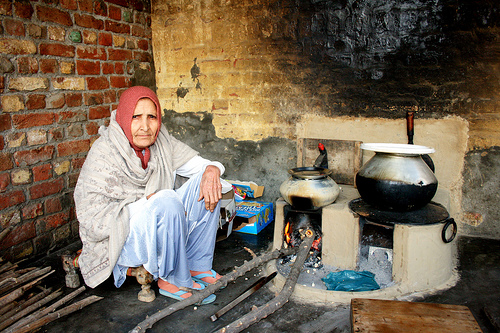
While driving home from a friend’s house one night I noticed something out of the corner of my eye as I passed the rows of darkened homes in his neighborhood. One garage door on the block was open and the garage lights were on, but there were no cars inside. Instead, there was an older Mata/Mai/Bibi/Bebe standing in front of a stove making roti, while a younger lady was dishing out what must have been some dal/sabzi.
The site was kinda cool and I had to resist the urge to stop my car and take a picture to post here – for fear of looking like a creepy weirdo. I did, however, think about it all the way home. What made it worth thinking about for a 10-minute drive is simple: it took me back to Punjab, where many farming families have two kitchens – one inside and one outside (where a bulk of the cooking is done).
I don’t know if it’s actually appropriate to say “Happy Hola Mohalla” or “Happy Sikh New Year” (doubt it) but these are the awkward felicitations we’re going to have since we blog in English…
According to the Nanakshahi calendar (a solar calendar which begins on what’s understood to be the day of Guru Nanak’s birth in 1469), the new year is approaching. New Year’s Day falls on March 13th of the Gregorian (Western) calendar. And Hola Mohalla, which is celebrated according to the Indian (lunar I think) calendar was celebrated today (March 11) in Anandpur Sahib. Too many calendars.
I had the immense pleasure of going to a Hola Mohalla a few years ago and have to admit that it was thrilling. The roads leading to Anandpur Sahib were teeming with Sikhs from all over Punjab, and some from further parts of the country. Buses came fully loaded, as did tractors and trucks with their backs open and passengers sitting inside, outside, and on top. Many people walked, some barefoot, from incredible distances. The roads were lined with sevadars serving langar to all the weary travellers- cha, samosay, cholay, pakoray! My mouth is watering at the memory… It was an amazing celebration and feeling of community. Gatka was fought, poetry was recited, and Holi revelers threw colors at anyone within range (such is the blend of celebrations in India… maybe everywhere for that matter).
Nihangs gathered to show off their weapons, athletic prowess and fighting techniques. Men of all ages- young and old- rode two horses at a time at full speed, standing up, (a few who had had too much bhang fell) down a long grassy field with the foothills that once gave their ancestors refuge from battle in the backdrop. It was easy to imagine that it was 300 years ago and these Nihangs (except the ones who fell from too much bhang) were preparing for a real battle.
[some more pictures below the fold]
If Baldev Mutta’s cellphone rings in the middle of a meeting, he picks it up. If it beeps over dinnertime or at midnight, he answers it. And if he has to go out to pick up a woman and find her a spot at a shelter at 3 a.m., he will do it. “It can mean the difference between life and death for a woman,” said Mutta, executive director of Punjabi Community Health Services in Brampton. “They are abused and don’t have anywhere else to go. This agency is their lifeline.” [link]
The Punjabi Community Health Services is an organization based in Brampton, Canada which provides various services to Punjabi women who have been abused. Instead of waiting for women to turn up at their doorstep, this organization takes a proactive approach by sending workers into the community to speak with abused women. They visit Gurdwaras and community centers to find women in distress. At times they must speak with the women secretly at doctor’s appointments, grocery stores, even parking lots, so their families don’t find out.
::
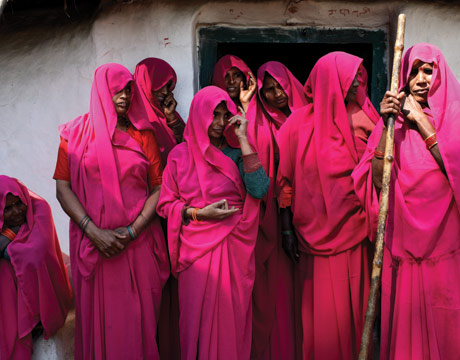 In related news, I recently read an article about the “Gulabi Gang” in an issue of Marie Claire which appeared on New America Media yesterday aswell. The Gulabi Gang are a group of women in India who have come together to fight against abuse. When local officials refused to take action against an alleged rapist, scores of pink-sari-clad women stormed the police station, demanding action – and thus, became know as the Gulabi Gang. For example, when Sampat Pal Devi learned that a friend had been beaten by her alcoholic husband and that the local police, chronically indifferent to violence against women, had looked the other way, something inside her snapped. In an effort to fight back, she gathered dozens of her female neighbors, armed them with sticks, and taught them how to fight back. Together, the self-declared Gulabi Gang have beaten up accused rapists, profligate officials, and husbands who’ve abandoned their wives.
In related news, I recently read an article about the “Gulabi Gang” in an issue of Marie Claire which appeared on New America Media yesterday aswell. The Gulabi Gang are a group of women in India who have come together to fight against abuse. When local officials refused to take action against an alleged rapist, scores of pink-sari-clad women stormed the police station, demanding action – and thus, became know as the Gulabi Gang. For example, when Sampat Pal Devi learned that a friend had been beaten by her alcoholic husband and that the local police, chronically indifferent to violence against women, had looked the other way, something inside her snapped. In an effort to fight back, she gathered dozens of her female neighbors, armed them with sticks, and taught them how to fight back. Together, the self-declared Gulabi Gang have beaten up accused rapists, profligate officials, and husbands who’ve abandoned their wives.
 Last week, the International Criminal Court (ICC), issued an arrest warrant for current President of Sudan, Omer Hassan Al-Bashir. Al-Bashir has been charged with five counts of crimes against humanity: murder, extermination, forcible transfer, torture and rape. He also faces two counts of war crimes. The ICC may be growing its first tooth.
Last week, the International Criminal Court (ICC), issued an arrest warrant for current President of Sudan, Omer Hassan Al-Bashir. Al-Bashir has been charged with five counts of crimes against humanity: murder, extermination, forcible transfer, torture and rape. He also faces two counts of war crimes. The ICC may be growing its first tooth.
Behind the warrant were the many groups that have tirelessly worked to bring global attention to the matter. The ‘Save Darfur’ campaign has been extremely successful example in rallying public support, beginning in churches and university campuses, to influence the public dialogue and bring pressure upon public officials. Through organizing local events, but aiming to influence public opinion on a global level, the campaign is a model in their use of new media, internet, and public rallies and theatre to bring attention to the genocide and plight of a people. While I am in admiration of the campaigns strategies and efforts, it is still worthwhile to ponder on global culpability in allowing such genocides to continue to occur.
As part of these efforts, the campaign has been successful in bringing pressure upon China for its continued support of the genocidal regime and its willingness to condone the Sudanese government’s behavior in its bid to keep receiving returns on its billions of dollars investment into the country’s oil industry. Although on some level I understand realpolitik and China’s strategy of attempting to find oil supplies in those states that are considered pariahs by the US in order for China to satiate its growing oil needs. Still I cannot condone such actions and cannot trade human life for oil.
Grassroots efforts and political efforts are starting to show that the pressure upon China for its support of Sudan is beginning to have effect. Steven Spielberg’s boycott of the Beijing Olympics was one example. Protecting Sudan through its veto ability in the Security Council of the United Nations (UN), it is understandable why world pressure focuses on China. It is heartening that the pressure may even be beginning to have some effect.
However, left out of the equation is India.
We’ve talked a little bit about the Sikh Youth Slate that ran for gurdwara elections — and won — in Surrey, as well as how mainstream Canadian media was framing the event. In that election, youth won the vote with a platform promising a focus on Sikhi, community-based service, and support for youth diversion activities (ie., building community space at the gurdwara so that adolescents didn’t get sucked into another world of criminal complexity).
What I didn’t know, at the time, was that shortly after the election, the outgoing gurdwara president filed a lawsuit challenging the process/legitimacy of the nominations for election (but not the election itself). A press release circulated today regarding the legal developments in the case, and as a non-Canadian, it is more than a little disorienting.
As I was randomly going through youtube clips a few days ago, I came across the above video of a group of Sikh children in Fremont, who learn kirtan in classical raags. Despite the poor audio, its obvious that they are good and I know this also from having heard them (and some of their contemporaries) in person – they are GOOD.
A couple of weeks ago Jodha reported on an article that brought to light the fact that Sikh children are practicing the tradition of kirtan, but what I think we didn’t discuss there is how this generation of Sikh musicians has really become one of classical musicians, learning stringed instruments of old and performing keertan in the Classical or raag framework. The growth has been obvious, especially in recent years – with the rise of institutions such as the The Raj Academy in Great Britain and the Gurmat Sangeet Department at Punjabi University Patiala, which specialize in providing instruction in traditional (classical) kirtan, and even the Miri Piri Academy in Amritsar of which the Chardi Kala Jatha (classically trained professional Sikh musicians who happen to be American in nationality) is a product.
Yes, I’m going to dare to talk about a film other than Slumdog Millionaire. This past weekend, I watched a film called Amal and I can’t stop thinking about it. While this movie has been shown at several independent film festivals, it hasn’t received the attention I think it deserves (actually, perhaps that’s a good thing – those films that get hyped are often dissapointing!). The story is quite simple,
AMAL, a multi-layered portrait of contemporary India, follows an auto-rickshaw driver in New Delhi (Amal) who is content with his small, but vital role in life. One day he drives an eccentric billionaire who, disguised as a vagabond, is searching the streets for the last morsel of humanity, and someone he can leave all his money to, and Amal’s life may change forever. AMAL serves up a visual feast for audiences. Filmed on location in New Delhi, India, this modern day fable asks the important question of what success means to each individual and ultimately reveals to audiences that the poorest of men are sometimes the richest.
It seemed pretty significant to watch this film during these pressing economic times. Amal, the lead role in the film, is played by Canadian actor Rupinder Nagra. A small role in the film is also played by Gurpreet Chana (The Tabla Guy). Gurpreet composed some of the music for the film too. If you manage to get your hands on this film, you won’t be dissapointed. In the meantime, here’s the trailer:

 I know, from personal experience, that Sikh student organizations are always looking for a way to “get involved” and participate in a good cause. So, when I read about a recent initiative encouraging this type of active involvement, I cheered (abeit silenty… and to myself). The Sikh Spirit Foundation is an organization dedicated to promoting sikh values through education. In line with this mission, the Foundation recently launched a contest looking for project ideas which could help sikh education or our local gurdwaras.
I know, from personal experience, that Sikh student organizations are always looking for a way to “get involved” and participate in a good cause. So, when I read about a recent initiative encouraging this type of active involvement, I cheered (abeit silenty… and to myself). The Sikh Spirit Foundation is an organization dedicated to promoting sikh values through education. In line with this mission, the Foundation recently launched a contest looking for project ideas which could help sikh education or our local gurdwaras.
Help us assist the Sikh Community. Tell us how you would spend $25,000 to improve Sikh education or your local gurduara for a chance to win an iPod!
Submit two written paragraphs explaining what you would do and how it would help the Sikh community. Ideas will be judged according to feasibility, impact and need.
The Sikh Spirit Foundation intends to pursue the winning idea this summer by inviting the global community to submit proposals for the project. The Foundation will select and fund the best proposal among the submissions. [link]
Some of the organization’s grantees include: Ensaaf, Gyan Sewa Trust, Nanakshahi, Sikh Coalition, SikhNet, Sikh Research Institute, and Ujjaldidar Singh Memorial Foundation.
We’ve previously discussed involvement in the Sikh cause and lac(k)tivism – so it would be great to hear how youth and student organizations take the opportunity to suggest solutions to problems in gurdwaras and provide ideas for improving sikh education. Whether we acknowledge this or not, we are building a world today where our children will live tomorrow. To see the positive impact, it really comes down to how much we are willing to invest in our community today. We encourage you to go directly to the website to read submission guidelines – however, if you’d like to leave some thoughts here too – we’d love to hear your ideas!
 Not in India! In India, the state only engages in what is euphemistically called “fake encounters.” While many in the Sikh community remember the tragic events of 1984, in many ways the events did not just transform the Sikh nation, but has had a lasting effect on the Indian state.
Not in India! In India, the state only engages in what is euphemistically called “fake encounters.” While many in the Sikh community remember the tragic events of 1984, in many ways the events did not just transform the Sikh nation, but has had a lasting effect on the Indian state.
Rarely do I see this line of questioning amongst Indian academics, elite, or the media. Violence does not only affect the victim, but the perpetrator is also transformed. Last week, I commented on one such transformation in the Indian State – when a mainstream journalist can openly call for “state terror(ism)” as a tactic to perpetrate against its own citizenry.
This week, in a related story, but still somewhat different, I highlight the euphemism “fake encounter”. Although this term had traction before 1984 and was one of the spearheads against which Baba Jarnail Singh Bhindranwale fought against, it was in the post-1984 Punjab that supposed “encounter deaths” became so widespread and with a complacent Indian press parroting the State’s reports soon found them relegated to back pages. If there truly is a “Punjab lesson”, it was that other Indian State agencies could engage in these “fake encounters” with complete impunity. The latest case comes from the state of Chhatisgarh and the rural areas near Singaram.
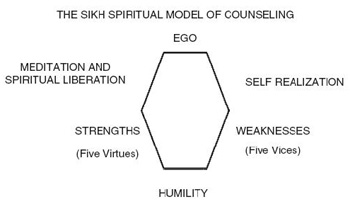 Despite the rich linguistic flexibility of Punjabi, it is telling that we do not have a single term for ‘depression.’ Mental health has been an ongoing conversation since the inception of the blog, repeatedly highlighted by Sundari and others. Often treatment is not sought and if it is sought it is usually terminated early as clients do not feel health professionals understand their world-view.
Despite the rich linguistic flexibility of Punjabi, it is telling that we do not have a single term for ‘depression.’ Mental health has been an ongoing conversation since the inception of the blog, repeatedly highlighted by Sundari and others. Often treatment is not sought and if it is sought it is usually terminated early as clients do not feel health professionals understand their world-view.
While we have numerous issues facing the Sikh community, there are few channels for those seeking mental health assistance. Thus, I was happily surprised when I came upon a medical article, titled “The Sikh Spiritual Model of Counseling.”
I reproduce the abstract in its entirety:
In accordance with the holistic principles of modern medicine, this paper will present the Sikh religious and spiritual view of mental health. With the continuing migration of a large number of South Asians, especially the Sikhs, to Western countries, mental health professionals should be aware of their clients’ world-view and cultural/religious specifi c models of counseling. Use of Sikh spirituality can reduce stress; help in treating psychosomatic disorders; and improve mental health of the individual and of the community. This paper will conclude that as the Sikh religion is a universal religion, everyone can use Sikh spirituality.
Dr. Kala Singh, the author of the article, is a physician that works as a multicultural mental-health liaison at Vancouver Coastal Health. I also want to personally thank the author for sending me a copy of his article!
 Assemblyman Warren Furutani (D-Long Beach) has introduced a new bill requiring awareness trainings and instruction on how to approach Sikhs for California’s law enforcement agencies and officers. If passed, California, which is home to the oldest Sikh gurdwara in the U.S. (Stockton) and one of the largest Sikh populations in the country, would take affirmative steps to ensure that the rhetoric around national security is not inappropriately utilized to prevent Sikhs from the free and fully practice of our faith.
Assemblyman Warren Furutani (D-Long Beach) has introduced a new bill requiring awareness trainings and instruction on how to approach Sikhs for California’s law enforcement agencies and officers. If passed, California, which is home to the oldest Sikh gurdwara in the U.S. (Stockton) and one of the largest Sikh populations in the country, would take affirmative steps to ensure that the rhetoric around national security is not inappropriately utilized to prevent Sikhs from the free and fully practice of our faith.
Assemblyman Furutani explained the need for this protection specifically in the context of the kirpan:
Since the Sept. 11 terrorist attacks, Sikhs carrying the blade, which they consider sacred, have experienced a sharp increase in prosecutions, according to the legislation, AB 504, that Furutani has introduced.
“The Sikh community should not live in fear of arrest by law enforcement for carrying the kirpan, which is an integral part of their religious faith.” [link]
In light of the horrific experience of the Tagore family in Texas, it sounds like this kind of forward-looking legislation could prevent instances of ignorance-based harassment, or at the very least provide a legal basis for holding police officers accountable to culturally appropriate standards of enforcement for the diverse communities in which they work. The bill will be reviewed in March, and it will be interesting to see if it’s able to gain political traction in the upcoming legislative session.
We have talked about ‘Slumdog Millionaire’ many times here at TLH. We have criticized the corporate double-standards, celebrated dhols, and even discussed ways to get involved.
Yes, many have jumped on the Slumdog bandwagon (TLH included!). However, this one takes the cake. The Congress-led UPA government in Delhi now counts Slumdog’s success as one of the government’s accomplishments.
In an unmistakable resonance of the previous NDA government’s `India Shining’ slogan, Congress floated the idea of an `achieving India’ and listed among the milestones the Indo-US nuclear deal, Chandrayaan, near 9% growth and the total sweep of the Oscars.[link]
I wonder – is the government celebrating its role in the creation of the slums? The facts don’t seem to lie as one article wrote:
Fact: The number of people living below the poverty line has actually increased by a horrifying 20 per cent. India had some 270 million people below the poverty line in 2004-5, when the present Government took office. That number has gone up by 55 million, or 20 per cent, after five years of policies named after the ‘aam admi’ (common man) but shaped for the ‘khaas admi’ (vested interests).[link]
The ridiculousness didn’t stop there.
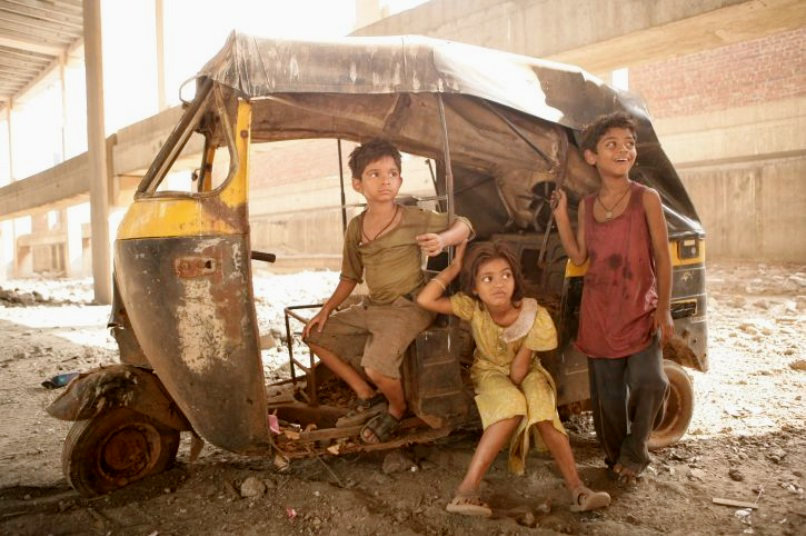 Amidst all the “Slumdog Millionaire” Oscar hysteria, some have been asking how are we ACTUALLY going to combat the issues of poverty in Indian slums? I heard on “Entertainment Tonight”, or some show like that, the movie’s directors/producers have set up a trust-fund for the child-stars (who currently live in slums), are paying for their families to move into decent apartments, and will be paying for the children’s education.
Amidst all the “Slumdog Millionaire” Oscar hysteria, some have been asking how are we ACTUALLY going to combat the issues of poverty in Indian slums? I heard on “Entertainment Tonight”, or some show like that, the movie’s directors/producers have set up a trust-fund for the child-stars (who currently live in slums), are paying for their families to move into decent apartments, and will be paying for the children’s education.
But how about the rest of the families who were cheering away in Mumbai slums as “Slumdog Millionaire” won its eight Oscars? I came across this great blog post by Minal Hajratwala, “Slumdog”: Don’t Just Watch, Do Something, which took scenes from the movie and talked about how we can address those poverty issues in reality. I am going to copy a few of those segments here, but please do visit Minal’s blog for the full-effect.
 While many may still be reveling in Slumdog’s Sunday limelight, a darker movie about Indo-Canadians in Vancouver (the vast majority of who are Punjabi-Sikh), aiming to shed light on gang violence, is sparking criticism. [See trailer here.]
While many may still be reveling in Slumdog’s Sunday limelight, a darker movie about Indo-Canadians in Vancouver (the vast majority of who are Punjabi-Sikh), aiming to shed light on gang violence, is sparking criticism. [See trailer here.]
The film titled “A Warrior’s Religion” was made by Mani Amar, who describes it as a poetic documentary. When asked about what drove him to make the film, he said:
“It had to be done. How many more people need to die? We are past the 130 mark of deaths in our community. The issue is not slowing down … How readily we have accepted gang violence and how engrossed we are in it is what propelled me to do it. We are so relaxed about an issue that we should not be relaxed about at all.” [link]
In the film, Mani interviews Bal Buttar, a high-profile former gang member who is now blind and a quadriplegic after being shot in a gang related incident.
Mani said: “When I met Buttar, I laid it out on the table directly to him and said to Buttar, “I don’t respect you. You have an opportunity in your life to show youth that this is what gang violence will bring you.” For whatever reason, Buttar accepted the challenge. In the end though, I reaffirmed that it’s only death or jail to get out.” For Mani, what resonated most from the interviews was Buttar’s way of explaining karma: “You take blood. That blood gets taken from you.” [link]
Controversy has arisen from the film’s name, “A Warrior’s Religion,” and its use of visual references to Sikhism through images of gurdwaras, scenes from a Vaisaikhi parade, martyrs, and an image of a khanda in flames with bullet holes in the background. Mani explains how he chose the name:
The Center for Asian American Media (CAAM) is a group working to present stories that convey the “richness and diversity of Asian American experiences” to the broadcast audience. They do this by funding, producing, distributing and exhibiting works in film, television and digital media. One example is this video directed for Mandeep Sethi, a bay area MC. As he says, Where do we go from here, I thought my people would be proud of their heritage and instead they want to bury it.
Also presented by the Center, is the upcoming 27th Asian American Film Festival in San Francisco. For those of you in the area, here are some of the films you might want to catch.
Judging from everyone’s facebook status (yes, this is what it has come to), people are excited about the numerous awards Slumdog Millionaire won at last night’s Oscars (yes, Jodha, I watch the Oscars too). As was anticipated, the rag-to-riches film won Picture of the Year. Among it’s other awards was A.R Rahman’s win for Best Song, Jai Ho.
As anticipated, the Oscars presented this catergory’s nominations by a live song/dance number (the other songs nominated were another SM number, O Saya and Down to Earth from the film Wall-E which was sung by the lovely John Legend). The stage was full of multicultural bollywood-style dancers and instrumentalists. And if you looked closely enough, scattered throughout the audience were dholis. I tried to dig up some information about who these dhol players were and found nothing on the internet (PR anyone?). However, thanks to the fact that punjabi kids know what’s going on with all things bhangra-related (not necessarily a good thing may I add), I found out that the group of guys playing the dhol were the north american group called Dhol Nation Jess & Jag Tooray and Shawn Khalsi (see the comments below for the discussion of who it was – like I said, some PR would have straightened this out). Since the Oscars were quite clearly on a date with India last night, it was nice to see the dhol exposure. This is the best video I could find (start watching at 2:45, and again at 5:40). If anyone has any other information about last night’s performance – please share it with us.

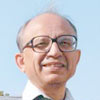 I have blogged about this issue before and since I find it so irritating, expect me to highlight them over and over. The most recent re-incarnation of the ‘abuse’ of the ‘Punjab Lesson’ comes from the always problematic Times of India. Swaminathan Aiyar, a libertarian columnist, in his “Swaminomics” has just written “Pakistan needs a Beant Singh”.
I have blogged about this issue before and since I find it so irritating, expect me to highlight them over and over. The most recent re-incarnation of the ‘abuse’ of the ‘Punjab Lesson’ comes from the always problematic Times of India. Swaminathan Aiyar, a libertarian columnist, in his “Swaminomics” has just written “Pakistan needs a Beant Singh”.
Decrying the truce reached by the Pakistani government and tribal forces in the Swat Valley, Aiyar sees parallels with India in the 1980s and specifically Punjab:
The Taliban’s rise in Pakistan has something in common with Bhindranwale’s rise in Punjab. A religious preacher, he sought to purge Sikhism of modern evils and return to pristine Sikhism. He was outraged by reformist Sikhs like the Nirankaris, and his followers killed many Nirankaris including the Nirankari Baba. [Emphasis added][link]
Nirkankaris were reformists? Claiming a living Guru that was greater than the Guru Granth Sahib and opening fire on protesting Sikhs in 1978 is reform? But I digress….

